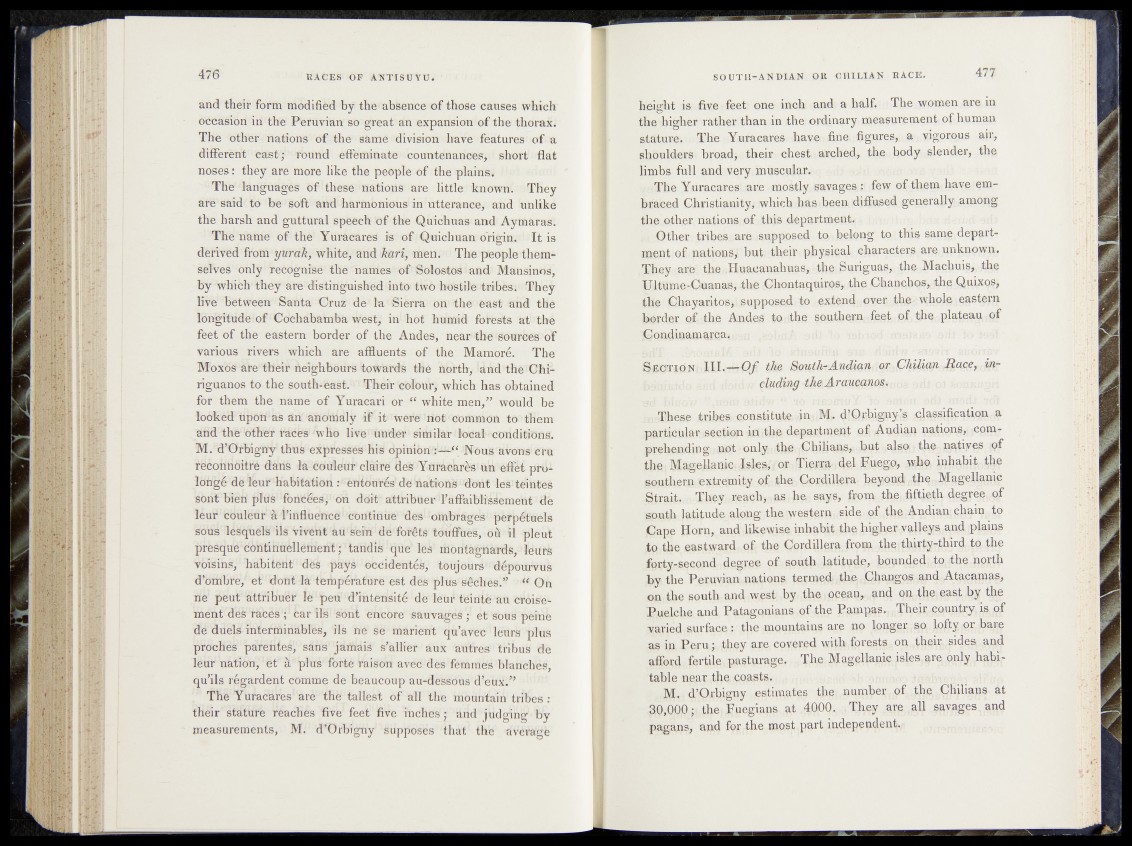
and their fbrmmodifièd bÿ the absence «of those eanses which'
occasion iii( the PetnYian’ gIPgreafcdn cxpansiois^of the^thoraxr
The other^!nat*ons- OT thefi^inae ^division have features*' of; a
different cast;ÎJ fbuiid e#hffiinate«ieonnteHanees)i‘ short flat
noses : they are more like the people of the iplainstf U
The' lartgüagéë Of * these- ‘nations are little: known< afTfiey
are said to be soft and harmonious: in utterance, and u nlike
the harsh and guttural speech of the QificfauaS'and Aytnaras.
The name' of the Yuracares Is of Quichuan briginaf* It is
derived from yurak, white, and kari, men. The people them^-
staves only! Ÿeeëgn?sërthè' ''nâfliesacf! SolostoS s and' Mansfabi/
by which they atC distinguished iinto two hostile ^rihOsss They
life 'Between' Santa Cruz dè-' la * -Sierra on; -the 'Cast i'ahà th'ê
îongittidëlof Cdéhàbamba Wést> inrihot humid fbtfests at thé
fèet of the eastern border of thé Ande^'near^efSOar^S'bï*
various rivers which are affluents of the Mamoré. The
Mbxbë%refhèir èeîghbôttrs towards the àbrth, ffidsthiiGhP-
riguanos to the south-east. ' Their colour, which has obtained
for them the name of Yuracari Or “ white men,” would be
looked üpôîfàs an ankuhdly if itifwefe !not- Common toefflem
and the other races-who live under* similar ^ocalretffldMbng.
M. d’OriKgh^ thus expresses'hiS bpMèncUu.p WOuS-ay^msiCTti
fëcottrioitré dénis laéOtfletffclMré ile^ jJwU
Ioflgé'âë leur^habitation :r entourés* de^aMonSidôiif leèîtéintèS
sohtbiefl plus 'fbnCëeëpon doit- attribuer d?aflfeibhéiëmeht J de
leur cOuleùr àA-irtflüetecë^eorftlntré1 ^ e s ''orjabrages pèrpéteéls
sohis lèsquéls ils vivent aù beih dé forêtê* toflffaêS, oà ii pleut
presque cohritinéîlëfflehfp! tandis! qnë M ! nlôritàf^àïds^lféirtë
voisins,1 habitent dëè pays accidentés, toujours ' dépourvus
d’Othbrë/ret^dont la tëifopérUtUre est des plus sèches.’®’ ■’** On
nè peut'Attribuer îë^eù^d’intehsité deléürteintë-an croisement
dlék'tàbés 1 car IIS 1 ;ébnt ënedre'' sauvages ;■ et1 'SotiS péinib
db duels interminables, ’ils né se marient qu’avec 'leurs plus
proches1' parbhteéy ’sàhs jafhàis s’allier aux autres' tribüs de
léüf niàtîën^ët' à ' plus forte raison avec des femmes blanches,
qu’ils régardent comme de beaucoup au-dessous d’eto:”
The YiifachVës^aré the tallest Of all the moùntaih triées :
their stature reaches five feet five inches ; and'judging* by
measurements, M. d’Orbigriy’ supposes that the avéra’gè
height is flye tf e tt one inch and a half.>: , The - women are in
the higher rather, than in ithe^ordinary» measurementipf human
stature. -1$ The ^Yj^awks^ihavieft ain,
shfiulderfe broad, their chest arched, h ^ r ?| the
limbs full; and .v^ryimuscuiar.^|
-The Ynracgiresi iare -mo^lyjSarage^iltfew of
bifaCed Giwistia*tyj;whichiha&(hneMi|ffi,^ ^ g ^ P § r^®3h?5^°W
thevothef J
in Other trib^iiare.ASiiippjRpe^ tPUJ'bfKS
menttof parionsT but-j-their. ph jmgadv'charae^^
, They care thfif.Hnaeanahuasg^thgip^igu^^rlhfeMaqhpile t^®
^tuuiejjQnanan^he
the Slhayai^osji^uppQs^i'to
herder ®£<tke Alaska’ toxitke
jQoi^iBam&rCPx e >
.fjf f l i ^ T T T . 4 ^ the South-Andian or Chilian Race, inw
$u&i@g isM^^JSfggSQfjoo
ffioBhose triheSs'(CPUStitiite.
in the department
prehendrogmiiiQt ‘onlyf^theqGhtli^i^shtUt j ($
SpntherBjpitomifycPfii^^ Qwskilf^a"
Strait.{,, They iteaebj ,a^ (hffe sayfs 4§i$^n{£f
jQape florn,
to the cast^wayd; of the Qprdhl§5^'from
o i snuth!;hati|B4p»
by the Peruvian nations termed, fth% rCha^ ^ r^ 4 A^B'I:BilB»
on. the south, and west; ,hy ,thetPPeai?» nan4 %
Puelche and Patagonians of ithe
v,arie4iSurhlG^ f;\^ e arf flp
as in Peru j . #y$y:'-9.r$; c p y ^ 4
afford .fertile, pasturage,
table ‘near theypa^ts•,,,
JM. A’Q|cpigpy fh^!
pagans, and for the mp&t .part independent.